Rabbi Yosef Konvitz
יוסף ב"ר אליהו חיים
President, Agudath HaRabonim of the United States and CanadaDate of Death:
Wed. June 14, 1944 -
Sivan 14 5704
Anyone with biographical information is asked to please send it in.
See CONTACT page for details. Thank you.
Directions to Kever: Located along the western slope of Tzfas, the Old Jewish Cemetery is one of the oldest in Eretz Yisroel. Location: Near the kever of his father-in-law the Ridbaz (see map below). Standing from the Ari HaKodosh platform it's up the hill to your right. The face of the kever is facing the old city.
Biographical Notes:

Source: Jewish Telegraphic Agency, June 8, 1944
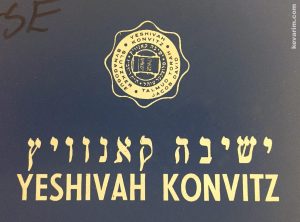
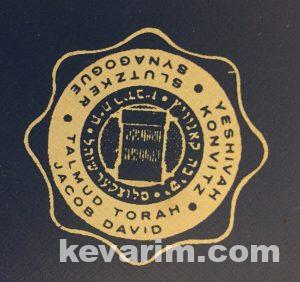
Photo Caption: Yeshiva Konvitz East Side Talmud Torah Slutzk, Credit: IFJCAH
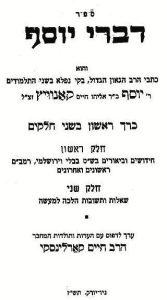
Photo Caption Flypage of Divrei Yosef, Credit: N/N
« Previous: Rabbi Dovid Aaron SoloveitchikNext: Rabbi Ephraim Tzvi Minsberg »



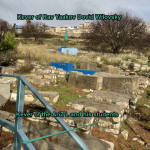
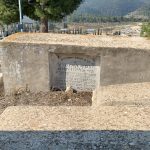

Rabbi Yaakov Dovid Wilovsky (Ridbaz) was his father-in-law.
He was the only person to serve as President of Agudath HaRabonim during the “Silver Years”.
Any idea where in Tzfas cemetery he’s buried? I looked near his FIL but didn’t notice his kever there.
Contact info for the old cemetery in Tzefas is listed here: https://mdzefat.co.il/בית-העלמין/
Maybe next time you’re there someone can help you.
A map of the different chelkos is at: https://mdzefat.co.il/wp-content/uploads/2021/03/מפה.jpg
An Excel spreadsheet of the kevarim there is at: https://mdzefat.co.il/wp-content/uploads/2021/03/רשימת-נקברים.xls
From those listings it has the Ridbaz at grave #111 and R. Yosef Konvitz at grave #108 – both in חלקה ב so it does seem like those kevarim should be near each other.
Another good site for that cemetery with searchable names is https://yichus.net/pages/cemetery/pa-safed.html
Harav Yosef Konvitz was born in Koshadar (Kaišaidorys), Lithuania to his parents, Eliyahu Chaim and Tzina Feige (Gobst). Koshadar, a tiny town without much of a Jewish population, was five miles from the nearest Jewish town of Zhezmir (Žiežmariai). As a child, he learned with his father, and at the age of nine he boarded in Zhezmir to join a group of boys who learned with a melamed.
At the age of twelve, the melamed convinced Eliyahu Chaim that his young son Yosef should transfer to Yeshiva Knesses Yisrael of Slobodka, and he wrote him a glowing letter of recommendation. Although Yosef was substantially younger that the other talmidim, he soon earned a reputation and an ilui and a masmid, and took a place amongst the elite of the yeshiva.
In 5657 (1897), a branch of the yeshiva was established in Slutzsk, and fourteen talmidim, who came to be known as the “Yad Hachazakah,” were sent to inaugurate it under the guidance of the Rav of Slutzsk, Harav Yaakov Dovid Willowsky, zt”l, known by the acronym Ridvaz. Yosef, only 19 years old, was a leader of the group, and a year later, he was chosen by the Ridvaz to marry his daughter, Welia. They settled in Slutzsk while he continued his learning.
In 1900, the Ridvaz made his first trip to America to raise funds to publish a Talmud Yerushalmi with his chiddushim, and when he set out for a second fundraising trip in 5662/1902, the town offered Rav Yosef to be the temporary Rav. In his humility, Rav Konvitz demurred and accepted the position of Rav in Shadova (Šeduva), followed by the Rabbanus in Kowarsk (Karvaskas) a year later. During this time, he wrote teshuvos which the Ridvaz published in his sefer Shu”t Beis Ridvaz in 5668/1908.
When the Ridvaz was appointed Rav of Tzfas and established Yeshiva Hagaon Ridvaz, he invited his son-in-law to join the yeshiva as a magid shiur, and Rav Konvitz arrived there on Chanukah, 5667. The yeshiva, which was not under the jurisdiction of any foreign government, suffered greatly from the financial demands of the Turkish authorities, and Rav Konvitz travelled to America to raise funds. While there, he managed to register the yeshiva as an American institution, which helped alleviate the need to pay the Turkish authorities the exorbitant fees they demanded.
In 5674/1914, the yeshiva was once again in a precarious financial situation, and Rav Konvitz travelled to England to bolster its support. WWI broke out during the week he intended to return to Eretz Yisrael, and as a citizen of Russia, who was fighting the Germans, it was dangerous for him to return to Palestine, which was under the jurisdiction of Turkey, an ally of Germany.
Rav Konvitz decided to travel to America temporarily, but the prolonged war forced him to accept the position as Rav of Elizabeth, New Jersey in 5675/1915. In 5679/1919, he became Rav in Trenton, and in 5684/1924 became the Chief Rabbi of Newark, officiating in the Russian Shul, the largest congregation in the area. During this period, he served as a member of the executive committee of the Agudas Harabanim, and went on to become the president of the organization. He was also a leader of Ezras Torah, which supplied much needed funds to talmidei chachamim and yeshivos.
Rav Konvitz took an active role in all areas of Orthodox communal life in the United States and Canada. In 1937, he convinced NYC Mayor Fiorello La Guardia to add kosher products to the food distribution to the city’s poor, thus opening the way for many indigent frum Jews to receive food with a proper hashgachah. In 5695/1935, when the Jewish Theological Seminary of Conservative Judaism wanted to institute a pre-nuptial agreement to allow wife to inaugurate a get, Rav Konvitz marshalled over 300 Rabbanim to ban the practice, and led a campaign to excommunicate the organization and its leaders.
Rav Konvitz health began to wane, and he started work on Divrei Yosef, a collection of his chiddushim in halachah and agaddah. When WWII broke out, his writing was sidetracked as he dedicated his last energy to working with the Vaad Hatzalah to save lives of the Jews in Europe.
Rav Yosef Konvitz was niftar on 15 Sivan, 5704/June 6, 1944, and was temporarily interred in Beth Joseph Cemetery in Newark. Two years later, when WWII ended, he was brought to permanent burial next to father-in-law in Tzfas.
Two volumes of Divrei Yosef were published posthumously in 1947 and 1948.
@B Karman, not to stir a cold pot too much, but Rabbi Konvitz was not the Chief Rabbi of Newark in 1924. The other Orthodox rabbonim in town refuted his claim to this title, and actually refuted the existence of any suhc title. Eventually gave the title to one of their own group, my great-grandfather Rabbi Yakov Mendelson, apparently as a final refutation of any other claim to it, since they had previously declared that nobody holds such a title. The titling was essentially equivalent to head of the va’ad hakashrus.